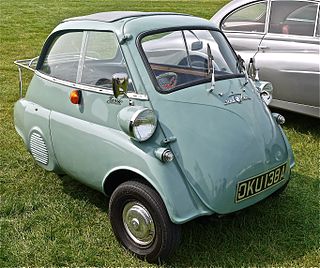
The Isetta is an Italian-designed microcar built under license in a number of different countries, including Argentina, Spain, Belgium, France, Brazil, Germany, and the United Kingdom. Because of its egg shape and bubble-like windows, it became known as a bubble car, a name also given to other similar vehicles.

A. J. Stevens & Co. Ltd was a British automobile and motorcycle manufacturer in operation from 1909 to 1931. The company was founded by Joe Stevens in Wolverhampton, England. After the firm was sold, the name continued to be used by Matchless, Associated Motorcycles and Norton-Villiers on four-stroke motorcycles until 1969, and since the name's resale in 1974, on lightweight, two-stroke scramblers and today on small-capacity roadsters and cruisers. The company held 117 motorcycle world records.

A drive shaft, driveshaft, driving shaft, tailshaft, propeller shaft, or Cardan shaft is a component for transmitting mechanical power and torque and rotation, usually used to connect other components of a drivetrain that cannot be connected directly because of distance or the need to allow for relative movement between them.

Motorcycles produced by Vincent H·R·D at their factory in Stevenage, Hertfordshire, England were renowned for their design innovation, engineering excellence and high performance. Already advertising their existing 110 mph Rapide machine as "The world's fastest production motorcycle", in February 1948 the distinctive Vincent Black Shadow was announced with a top speed of 125 mph. Built in three different Series over the course of its life, the line continued until 1955, after which the company stopped all motorcycle production.

A motorized bicycle is a bicycle with an attached motor or engine and transmission used either to power the vehicle unassisted, or to assist with pedalling. Since it sometimes retains both pedals and a discrete connected drive for rider-powered propulsion, the motorized bicycle is in technical terms a true bicycle, albeit a power-assisted one. Typically they are incapable of speeds above 52 km/h (32 mph).

The Cotton Motor Company, was a British motorcycle manufacturer of 11a Bristol Road, Gloucester, and was founded by Frank Willoughby Cotton in 1918. F.W. presided over the company until his retirement in 1953. The company was reconstituted as E. Cotton (Motorcycles) Ltd, and traded until 1980. The marque was later resurrected in the late 1990s by a business which manufactured replicas of earlier machines.
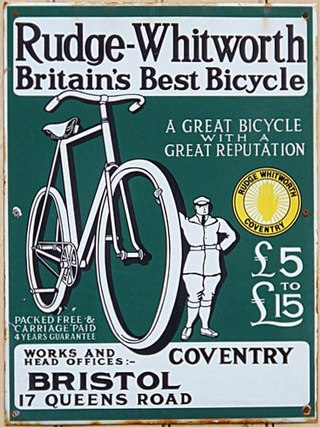
Rudge Whitworth Cycles was a British bicycle, bicycle saddle, motorcycle and sports car wheel manufacturer that resulted from the merger of two bicycle manufacturers in 1894, Whitworth Cycle Co. of Birmingham, founded by Charles Henry Pugh and his two sons Charles Vernon and John, and Rudge Cycle Co. of Coventry.

Douglas was a British motorcycle manufacturer from 1907–1957 based in Kingswood, Bristol, owned by the Douglas family, and especially known for its horizontally opposed twin cylinder engined bikes and as manufacturers of speedway machines. The company also built a range of cars between 1913 and 1922.

The AJS V4 started out as a prototype air-cooled V4 road bike, but became a water-cooled and supercharged racing bike.
Rex, Rex Motorcycles, Rex-Acme, was a car and motorcycle company which began in Birmingham, England in 1900. Rex soon merged with a Coventry maker of bicycles and cars named Allard and then later in 1922 the company merged with Coventry's 'Acme' motorcycle company forming 'Rex Acme'. The company existed until 1933, and, in its heyday, was considered one of the greatest names in the British motorcycle industry.
FN is a Belgian company established in 1889 to make arms and ammunition, and from 1901 to 1967 was also a motorcycle manufacturer. FN manufactured one of the world's first four-cylinder motorcycles, was famous for the use of shaft drive in all models from 1903 to 1923, achieved success in sprint and long-distance motorcycle racing, and after 1945, also in motocross.
The Elfe was a French automobile, manufactured in Lavallois, Paris, from 1919 until about 1925 by Ateliers Defrance Freres. The company was founded by M. Eugene Mauve, who was also the instigator of the Bol d'Or race for cyclecars and latterly motorcycles, now held at the Le Mans circuit in France. During its brief life, the company entered numerous races, under various names including ELFE, Elfe-Anzani, Elfe-DeFrance and Mauve.
Motorcycle components and systems for a motorcycle are engineered, manufactured, and assembled in order to produce motorcycle models with the desired performance, aesthetics, and cost. The key components of modern motorcycles are presented below.
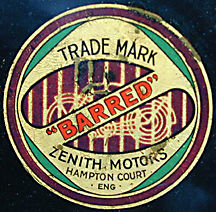
Zenith Motorcycles was a British motorcycle and automobile manufacturer established in Finsbury Park, London in 1903, by W.G. Bowers. Automobile manufacture only lasted from 1905–1906. The first Zenith motorcycle was the 'BiCar' of 1903, based on Tooley's Bi-Car design, which was purchased by Zenith for its own production. The BiCar was a unique design with hub-center steering and a low-slung chassis with the engine centrally fixed.
The Magic Midgets were a number of record-breaking 750cc "midget" MG cars of the 1930s. They were most notably, but not always, driven by George Eyston.

The Ruby Cycle Co Ltd. was a British motorcycle manufacturer based in Ancoats Manchester. Founded in 1909 the factory produced a range of motorcycles under the Royal Ruby brand until 1932.
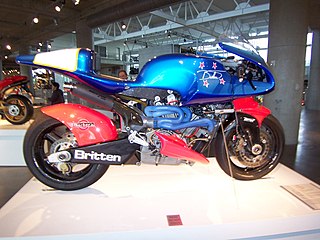
The Britten V1000 is a handbuilt race motorcycle designed and built by John Britten and a group of friends in Christchurch, New Zealand during the early 1990s. The bike went on to win the Battle of the Twins in Daytona International Speedway's Daytona Bike Week festivities in the United States and set several world speed records.

The Dax Rush is a lightweight two-seater sports car that's offered as a kit. It has a multi-tube triangulated steel space frame chassis, front engine and rear wheel or four wheel drive. The body is constructed in Glass-Reinforced Polymer (GRP) with optional aluminium side panels and bonnet. It complies with the Single Vehicle Approval (SVA) scheme. Two optional rear suspension technologies are offered; De Dion and the IRS. The car is known for its 0–100 km/h performance of close to 3 second runs.

Jarvis & Sons Limited were South London-based motor dealers for Morris and MG, and latterly coachworks providing special bodies for various car chassis until after World War II.
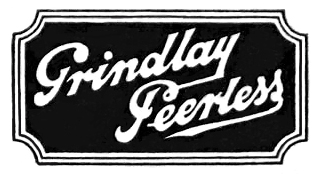
Grindlay Peerless is a historic motorcycle manufacturer that operated out of Coventry, England, throughout the early 20th-century, specialising in racing machines including the record breaking 498cc Grindlay Peerless.














